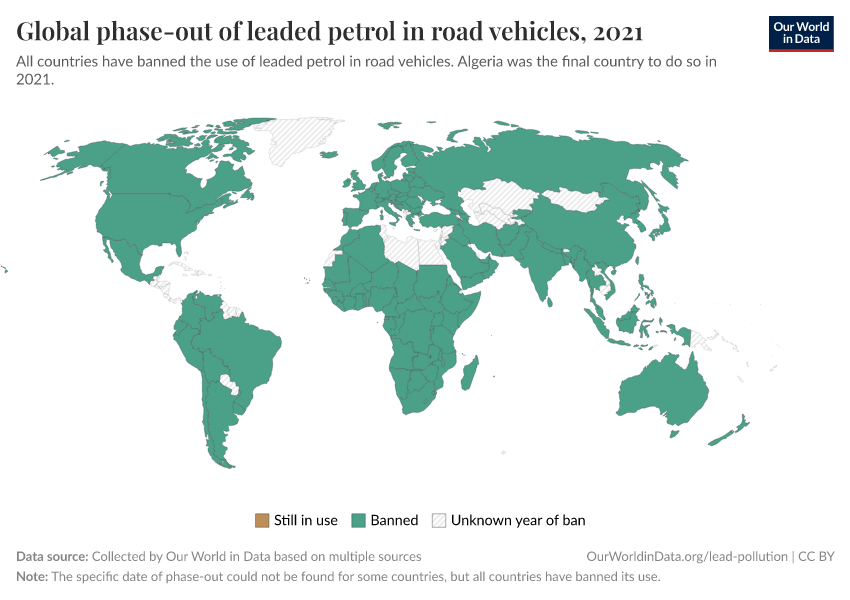How the world eliminated lead from gasoline
In 2021, Algeria became the last country to ban leaded gasoline. How did the world achieve it?
Thomas Midgley Jr. has been named a “one-man environmental disaster” for two big reasons.
He was one of the early pioneers of chlorofluorocarbons (CFCs) – compounds that became widely used in industry – and which were destroying the ozone layer.
He also invented leaded gasoline and insisted that it was safe to use. This turned out to be wrong. It exposed large numbers of people to lead poisoning, which is linked to elevated blood pressure and kidney damage; as well as the impairment of brain development and cognitive function in children.1
The world started adding lead to gasoline in the 1920s. The reason was that it is an ‘antiknock agent’ which improved the efficiency of vehicles and the performance of the engine. It turned clunky engines into smoothly running engines.
But lead proved to be a toxic pollutant – particularly for children. Using it in gasoline was polluting the air in towns and cities across the world, with large impacts to human health.
There had been concerns about the health impacts of leaded gasoline throughout most of the first half of the 20th century. However, with no real empirical evidence to show, these worries were quickly dismissed. It wasn’t until 1969 that the first clinical studies showed that it had toxic impacts on humans.2 From there, the evidence of the extent of lead poisoning, and its potential link with poor cognitive performance in children, continued to grow.3
In response, many countries began to phase out leaded gasoline in the 1970s. The US Environment Protection Agency, for example, issued guidelines to reduce lead content in 1983. But it wasn’t until 1986 – six decades after its introduction – that Japan became the first country to ban it completely. Three and a half decades later – in 2021 – Algeria became the last country to ban it.4
In the interactive map [you can use the time-slider at the bottom to go back in time] you can see how the world achieved this: year-by-year more and more countries banned it.

Change can happen quickly
It took long to react, but once the evidence was there and the first country banned it is staggering how quickly some of this progress was made. In 2002, the United Nations Environment Programme (UNEP) launched a programme to eliminate leaded gasoline in road vehicles globally.5 In the map below we see the status of leaded gasoline in Sub-Saharan Africa in 2002. It was still in use in nearly every country. By 2006, it had been banned everywhere in the region. Within only a few years it had been completely eliminated.
Action can happen quickly. Especially when there are large threats to human health on the line. The pace of action on leaded gasoline should make clear that this same pace could be replicated in other important areas.


Keep reading at Our World in Data
Endnotes
Attina, T. M., & Trasande, L. (2013). Economic costs of childhood lead exposure in low-and middle-income countries. Environmental health perspectives, 121(9), 1097-1102.
Lanphear et al. (2005) Low-Level Environmental Lead Exposure and Children’s Intellectual Function: An International Pooled Analysis. Environmental Health Perspectives.
Stasik, M., Byczkowska, Z., Szendzikowski, S., & Fiedorczuk, Z. (1969). Acute tetraethyllead poisoning. Archiv für Toxikologie, 24(4), 283-291.
The psychologist, Herbert Needleman, was one of the leading researchers in this area. He published several works measuring levels of lead exposure in children – often through lead concentrations in their teeth – and correlations between lead exposure and school performance.
Needleman, H. L., Davidson, I., Sewell, E. M., & Shapiro, I. M. (1974). Subclinical lead exposure in Philadelphia schoolchildren: identification by dentine lead analysis. New England Journal of Medicine, 290(5), 245-248.
Leaded gasoline is now banned for use in road vehicles in every country. It is still used in some smaller planes in the aviation industry.
This campaign was part of its Partnership for Clean Fuels and Vehicles (PCFV) programme.
Cite this work
Our articles and data visualizations rely on work from many different people and organizations. When citing this article, please also cite the underlying data sources. This article can be cited as:
Hannah Ritchie (2022) - “How the world eliminated lead from gasoline” Published online at OurWorldinData.org. Retrieved from: 'https://archive.ourworldindata.org/20251125-173858/leaded-gasoline-phase-out.html' [Online Resource] (archived on November 25, 2025).BibTeX citation
@article{owid-leaded-gasoline-phase-out,
author = {Hannah Ritchie},
title = {How the world eliminated lead from gasoline},
journal = {Our World in Data},
year = {2022},
note = {https://archive.ourworldindata.org/20251125-173858/leaded-gasoline-phase-out.html}
}Reuse this work freely
All visualizations, data, and code produced by Our World in Data are completely open access under the Creative Commons BY license. You have the permission to use, distribute, and reproduce these in any medium, provided the source and authors are credited.
The data produced by third parties and made available by Our World in Data is subject to the license terms from the original third-party authors. We will always indicate the original source of the data in our documentation, so you should always check the license of any such third-party data before use and redistribution.
All of our charts can be embedded in any site.